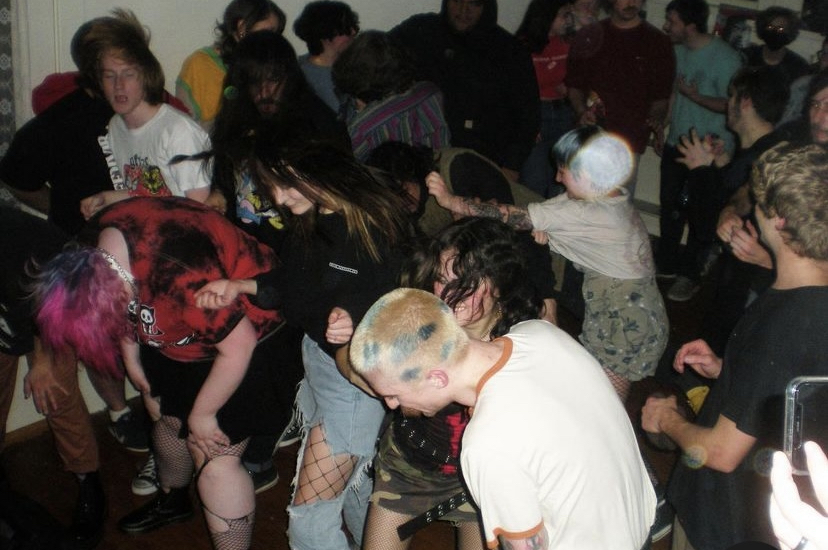Mosh pits create circles of holiness for women and LGBTQ people – The Columbia Chronicle

Editor’s note: This article is from the award-winning Echo magazine in the Communications department.
When I was 13, I dreamed of dancing in the middle of a sweaty crowd at a rock concert, religiously listening to L7’s “Bricks Are Heavy” and The Stooges’ “Raw Power” on vinyl. My fantasy was to bask in the glory of hearing a favorite song played at 50 times the normal volume, as I shouted the lyrics and rubbed against the sweaty bodies of strangers. Perhaps the greatest thrill in life for me is the feeling of euphoria that comes from heavy, distorted guitar riffs and vocalists threatening to burst my eardrums.
As a woman, my goal was to explore what punk meant on my own terms, and that includes finding safe spaces to dance freely without worrying about harassment from creepy booze-soaked men.
When I migrated from listening to punk music to Chicago’s heavy-punk hallowed grounds — such as Exit and The Empty Bottle — and abandoned warehouses, I was surprised at how inclusive the spaces were. towards women, people of color and LGBTQ+ people. As my love for punk music deepened – especially girl bands – I started hanging around the barricades and admiring the female leads singing about getting their bodies back.
In the early punk and male-dominated subcultures, women often stood in the back and watched the band from afar. Riot Grrrl, a 90s third-wave subcultural feminist movement, broke that mold in the 90s by stopping shows to escort girls to the frontlines safely. Feminism has taken on new meaning in punk culture, and women can now be the lead singers, drummers, and mosh pit instigators at any sold-out house show or festival.
The pit energy is contagious and the men aren’t the only ones in the circle right in front of the stage. Now, there too, the women are kicking and screaming. The perception of angry, testosterone-driven white men in the scene contrasts with the reality of a punk show that embraces an array of races and sexualities. This diversity is also on stage with a lead singer who has dyed hair, freedom spikes and dozens of tattoos adorning his body.
It’s not a fight. Moshing is an intense, collective experience that is a physical way of matching your body and energy to live music. The origins of moshing (originally called “mashing” until Bad Brains frontman HR changed the “a” to “o”) come from the American heavy rock movement in the late 70s and early 1970s. 80s, when punk and grunge were exposed to the mainstream.
Amaris Edwards, a member of the Chicago punk scene and a regular at concerts, considers the booths a safe space.
“A mosh pit looks intimidating, because when you look outside it looks like a lot of people jostling and making noise. But I feel like it’s an outlet for me to let out some emotions,” Edwards says. “The moshers make sure people don’t get hurt – the intention is not to hurt people but just to have a good time.”
The anti-authoritarian energy of the mosh pits provides a space for emotional release and physical healing, as bands sing about religion, lawlessness and politics. For Edwards, there is freedom of expression in moshing.
“There are conversations of angst and denouncing the system and releasing those emotions,” Edwards says. “I feel like it’s a safe space for people who understand that a certain kind of angst comes with society and the politics that’s played out on black and brown people.”
The energy is uplifting, reckless, and therapeutic, and mosh pits are entirely voluntary. Of course, bystanders can’t just jump into a pit with the intention of creating violence and hurting other moshers. There are basic rules of etiquette and codes of conduct that moshers must adhere to, to protect themselves and everyone involved.
As the moshers slap, elbow and kick each other, some with bloody faces and ripped out piercings, rule number one is that if someone is knocked to the ground, the other moshers help them. immediately to get up. And if a mosher gets hurt, he is taken out of the pit and taken care of. The purpose of a mosh pit is to push each other, but never to intentionally hurt anyone or fight.
Mosher punk Taylor Brown has been a fan of local Toronto punk artists for five years and feels comfortable amidst the chaos because of these rules.
“I appreciate [moshing] despite the fact that [even though] it’s very chaotic, it’s a caring environment,” says Brown. “If someone drops their phone, everyone stops and finds it. For the most part, people don’t mosh maliciously.”
In the pit, moshers can make friends and bond through music and the exchange of energy.
“It’s about coming together, shouting the lyrics that everyone loves,” Brown says. “It’s more of a connection to find those weirdos who also like that music that you like.”
I’ve had my fair share of hair-pulling, bruising and aggressive banging, but punk music and cheap local shows have given me space to thrive, not only broadening my taste for fashion, but also by boosting my confidence. Anger release isn’t just for men, and safe spaces like pits are a great way to release rage and manifest angst.
Dancing with other women with sweaty faces, smudged makeup, and chain link leather platforms creates a healing space for me. It’s a dream come true for my anxious teenage self. It could be the same for you.
You can read the full Echo issue 2022as well as previous issues, on our website.
